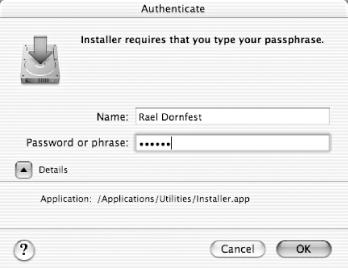Becoming an Administrator for a Moment
Your Mac does its best to protect you from yourself and your family by requiring authentication, both in the GUI and on the command line, when you’re about to do something potentially problematic.
OS X, being a multiuser Unix system at its heart, tries to prevent you (or your family) from doing anything that might adversely affect your Mac. It does so by denying access to particular files that keep your system running and disallowing actions that it considers potentially harmful. Every now and again, however, you need to install a piece of software or touch a vital Unix configuration file to get something done. Before it’ll let you do so, OS X will require that you authenticate yourself as an administrative user, known in Unix parlance as root.
Desktop Root
While most applications can be installed simply by dragging them into the Applications folder, some require a little more tomfoolery. Application and package installers often need to create folders, drop files into place, and adjust configuration settings in restricted parts of the operating system.
At these times you’re either not allowed to continue if you’re not listed as an administrative user of the system (take a look at the System Preferences → Users pane) or prompted for your password if you are. A typical Authenticate dialog looks like Figure 5-9.

Figure 5-9. Authenticate dialog ...
Get Mac OS X Hacks now with the O’Reilly learning platform.
O’Reilly members experience books, live events, courses curated by job role, and more from O’Reilly and nearly 200 top publishers.

